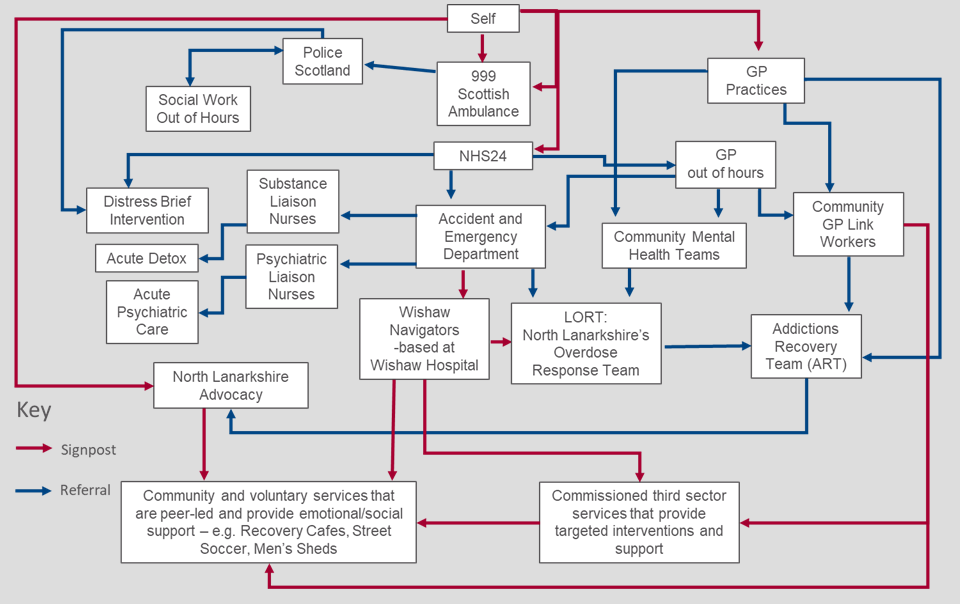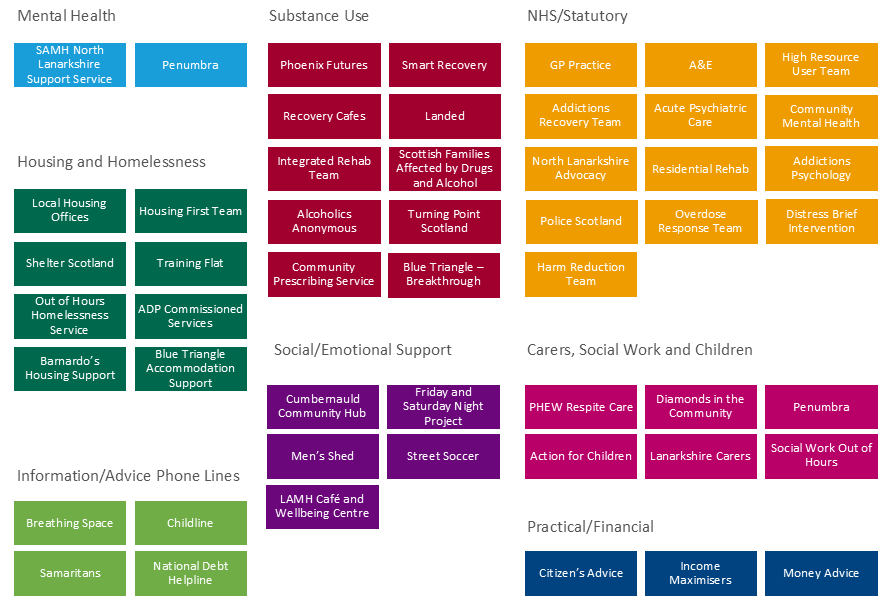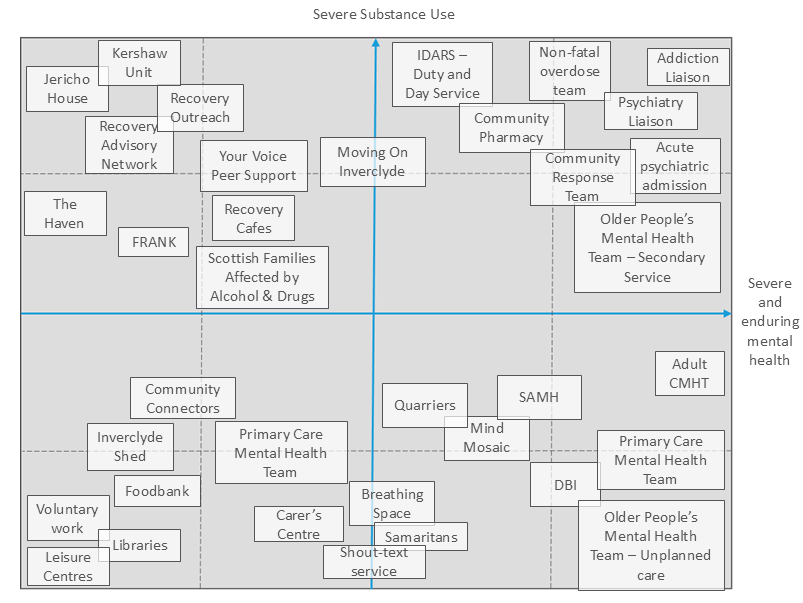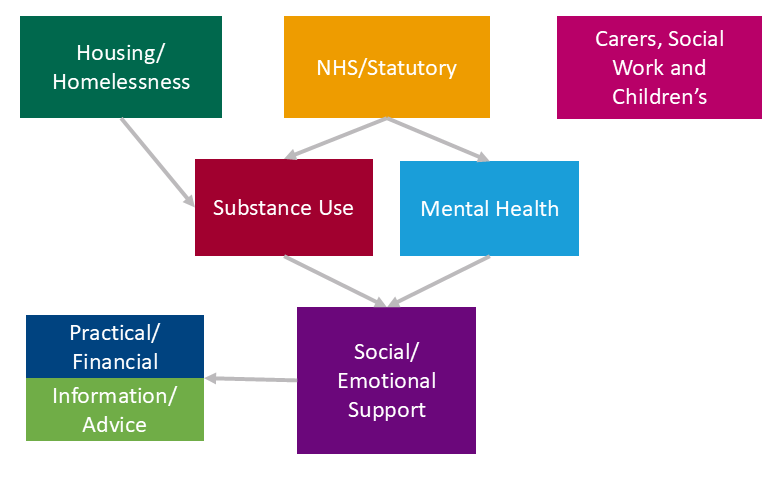Strategic Planning: Interconnected System Map
About Interconnected System Mapping
Using this tool, you can create a visual overview of your whole system. It can be done in different ways but fundamentally Interconnected System Maps are about understanding the different parts of your system, the services within it and how they relate. Maps are co-produced with community, health and social care organisations, using qualitative and quantitative information to gain system insights, through:
- Making a complex system visible,
- developing shared understanding of the interconnectedness of a system and the roles within it,
- analysing the gap between the ‘as is’ and ‘to be’ states, and
- diagnosing issues across multiple parts of the system.

North Lanarkshire ISM mapping session output
Supporting protocol – how you might use this tool
When looking at adapting and implementing a local mental health and substance use protocol, this tool can:
- Highlight all services that support people who have co-occurring mental health and substance use support needs (not just condition specific services)
- provide a foundational understanding of the system that can support conversations about pathways across services
- note key interfaces between services and their dynamics
- support analysis of the balance of care between statutory and community services
- identify gaps in services across a spectrum of need
This will stimulate conversations to shape ideas around ‘no wrong door’ approaches, the role of the third sector, care navigation and how to build connections across mental health and substance use services.
Planning your workshops
Two workshops are required for this. A virtual one to identify and start to categorise the services within the system. And a second, (ideally) in-person workshop that allows for closer, more focussed analysis around an issue or question of your choice.
The two workshops should be at most three weeks apart. And be attended by the same people.
What you need to do before
- You need to decide which mapping approach you would like to take and what you are seeking a greater understanding of. This toolkit outlines two approaches to mapping:
- Approach One: Mapping services to need
- Approach Two: Mapping system flows
- An understanding of the types of services in your area, to help prompt discussion.
What you will need for the session
- A platform that allows for the sharing of virtual ‘post-its’ such as Miro or Whiteboard
- Templates for the type of mapping approach you want to do.
- Discussion questions and facilitator prompts.
Who should be involved
- Staff from across the whole system, including third sector services.
- It will be important to have some operational staff who are able to highlight smaller/other services that they know people use.
- Discussion groups of up to 8-10 people.
Workshop 1 (Virtual)
This first session concentrates on who is in the system and who do you want to connect with. The key aims being to collect information on the different services and support available for people with co-occurring needs.
Supporting resources for this tool
Activity
Understanding the services: Invite participants to note down all of the services they are aware of that support people who have co-occurring mental health and substance use conditions. Be sure to include non-clinical and non-condition specific services. They should provide information about:
- What support they provide
- Any access requirements/criteria
- Where the support is provided (e.g. support to live at home, community services, hospital based service etc.)
This can be done through people posting services in the chat, or ideally, using an online application such as Miro or Whiteboard that allows for collaborative worksheets.
Post-event
Using the raw data collected, populate the 'ISM - location of services' template.
|
Output: Services and where they support people
|
|
Identifying the different settings that services provide support to people in. |
 |
Workshop 2 (In-person)
This follow up session is more adaptive to the particular question/issue you are wanting to explore. There are two sections to this workshop.
Section One: Categorising the services noted from Workshop 1.
Section Two: Mapping services. There are two approaches you can take for this, which are outlined below.
Supporting resources for this tool
Section One: Categorising Services
The first activity for either approach is to categorise the highlighted services from Workshop One.
Invite participants to arrange the identified services into categories relating to what support they provide to people. Try to encourage them to create their own categories and be led by how they see services as seen below:

Section Two: Mapping Services
There are two ways you can do this – depending on what it is you are looking to find out.
Approach One: Mapping Services onto the Four Quadrants
Approach One maps services around how they can meet different needs. This will support conversations about gaps in support for co-occurring needs, as well as highlight clusters of services.
Invite participants to discuss the type of support provided by services and agree which cohort across the Four Quadrants they best serve.

Discussion points:
- Is the service for people with co-occurring conditions?
- Does the service provide support for co-occurring conditions?
After the map has been developed, reflect on:
- How did we define the boundaries across the quadrants?
- Where do we see groups of services and how to they interact?
- Where there are gaps, do we try and build new services or expand the scope of existing ones?
Approach Two: Mapping System Flows
Approach Two maps service ecosystems through how people move through the system. This will enable you to identify the dynamics of connections across services. It will support conversations about interfaces between services.
Invite participants to choose a service and then map out the different pathways into and out of that service.
Repeat this with another service included in map and continue, to build a broad web of services and their connections.


On each of the connections note:
- Is it a referral or signposting?
- What are the access criteria? (and what are the resulting pathways if access is denied)
- Who makes the decisions at each connection?
After the map has been developed, reflect on:
- Can you find any ‘wrong doors’?
- Are decisions being made jointly?
- Where there is signposting does there need to be additional support for people?
- Are there adequate alternatives where a referral is rejected?
